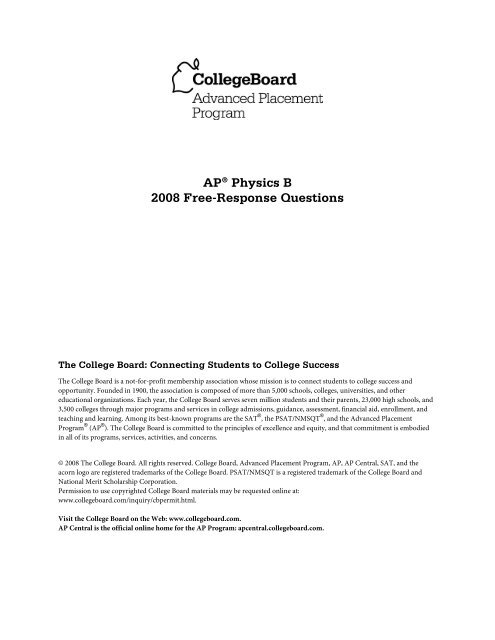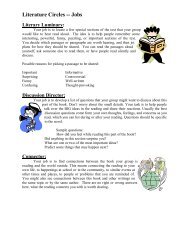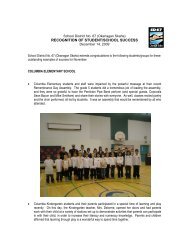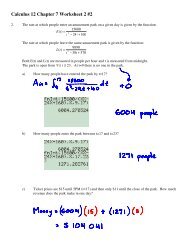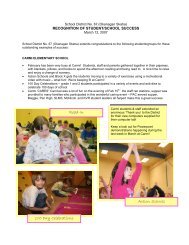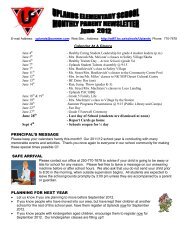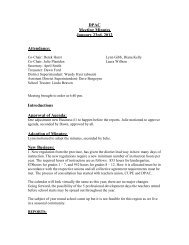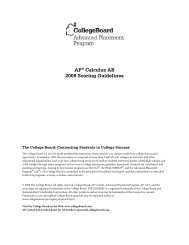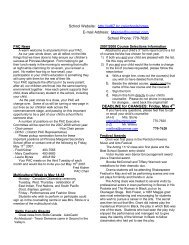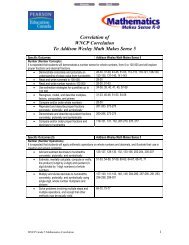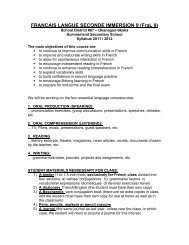AP® Physics B 2008 Free-Response Questions - AP Central ...
AP® Physics B 2008 Free-Response Questions - AP Central ...
AP® Physics B 2008 Free-Response Questions - AP Central ...
You also want an ePaper? Increase the reach of your titles
YUMPU automatically turns print PDFs into web optimized ePapers that Google loves.
<strong>AP</strong> ® <strong>Physics</strong> B<br />
<strong>2008</strong> <strong>Free</strong>-<strong>Response</strong> <strong>Questions</strong><br />
The College Board: Connecting Students to College Success<br />
The College Board is a not-for-profit membership association whose mission is to connect students to college success and<br />
opportunity. Founded in 1900, the association is composed of more than 5,000 schools, colleges, universities, and other<br />
educational organizations. Each year, the College Board serves seven million students and their parents, 23,000 high schools, and<br />
3,500 colleges through major programs and services in college admissions, guidance, assessment, financial aid, enrollment, and<br />
teaching and learning. Among its best-known programs are the SAT ® , the PSAT/NMSQT ® , and the Advanced Placement<br />
Program ® (<strong>AP</strong> ® ). The College Board is committed to the principles of excellence and equity, and that commitment is embodied<br />
in all of its programs, services, activities, and concerns.<br />
© <strong>2008</strong> The College Board. All rights reserved. College Board, Advanced Placement Program, <strong>AP</strong>, <strong>AP</strong> <strong>Central</strong>, SAT, and the<br />
acorn logo are registered trademarks of the College Board. PSAT/NMSQT is a registered trademark of the College Board and<br />
National Merit Scholarship Corporation.<br />
Permission to use copyrighted College Board materials may be requested online at:<br />
www.collegeboard.com/inquiry/cbpermit.html.<br />
Visit the College Board on the Web: www.collegeboard.com.<br />
<strong>AP</strong> <strong>Central</strong> is the official online home for the <strong>AP</strong> Program: apcentral.collegeboard.com.
Proton mass,<br />
Neutron mass,<br />
m p<br />
m n<br />
TABLE OF INFORMATION FOR <strong>2008</strong> and 2009<br />
CONSTANTS AND CONVERSION FACTORS<br />
27<br />
1.67 10 kg Electron charge magnitude,<br />
27<br />
19<br />
e 1.60 10 C<br />
1.67 10 kg<br />
19<br />
1 electron volt, 1 eV 1.60 10 J<br />
31<br />
8<br />
Electron mass, m e 9.11 10 kg<br />
Speed of light, c 3.00 10 m s<br />
23 -1 Universal gravitational<br />
11 3 2<br />
Avogadro’s number, N0 6.02 10 mol<br />
constant,<br />
G 6.67 10 m kg<br />
s<br />
Universal gas constant, R 8.31 J (mol<br />
K)<br />
Acceleration due to gravity<br />
2<br />
at Earth’s surface,<br />
g 9.8 m s<br />
23<br />
Boltzmann’s constant, 1.38 10 J K<br />
k B<br />
27 2<br />
1 unified atomic mass unit, 1 u 1.66 10 kg 931 MeV c<br />
Planck’s constant, 34 15<br />
h 6.63 10 Js 4.14 10 eV<br />
s<br />
Vacuum permittivity,<br />
Coulomb’s law constant,<br />
Vacuum permeability,<br />
Magnetic constant,<br />
25 3<br />
<br />
hc 1.99 10 J m 1.24 10 eV nm<br />
12 2 2<br />
0 8.85 10 C Nm<br />
0<br />
9 2 2<br />
k 14p<br />
9.010 Nm C<br />
7<br />
m0 4p<br />
10 (T<br />
m) A<br />
7<br />
0 <br />
k m 4 p <br />
10 (T m) A<br />
5 2 5<br />
1 atmosphere pressure, 1 atm 1.0 10 N m 1.0 10 Pa<br />
UNIT<br />
SYMBOLS<br />
meter, m mole, mol watt, W farad, F<br />
kilogram, kg hertz, Hz coulomb, C tesla, T<br />
second, s newton, N volt, V degree Celsius, C<br />
ampere, A pascal, Pa ohm, W electron-volt, eV<br />
kelvin, K joule, J henry, H<br />
PREFIXES<br />
VALUES OF TRIGONOMETRIC FUNCTIONS FOR COMMON ANGLES<br />
Factor Prefix Symbol q 0 30 37 45 53 60 90 <br />
9<br />
10 giga G sinq 0 12 35 22 45 32 1<br />
6<br />
10 mega M cosq 1 32 45 22 35 12 0<br />
3<br />
10 kilo k tanq 0 33 34 1 43 3 <br />
2<br />
10 centi c<br />
3<br />
10 milli m<br />
6<br />
10 micro m<br />
9<br />
10 nano n<br />
12<br />
10 pico p<br />
The following conventions are used in this exam.<br />
I. Unless otherwise stated, the frame of reference of any problem is<br />
assumed to be inertial.<br />
II. The direction of any electric current is the direction of flow of positive<br />
charge (conventional current).<br />
III. For any isolated electric charge, the electric potential is defined as zero at<br />
an infinite distance from the charge.<br />
IV. For mechanics and thermodynamics equations, W represents the work<br />
done on a system.<br />
-2-
ADVANCED PLACEMENT PHYSICS B EQUATIONS FOR <strong>2008</strong> and 2009<br />
u u 0 at<br />
1<br />
x x0 u0t at<br />
2<br />
u<br />
2 2<br />
u0 2a x x0<br />
F F ma<br />
Ffric<br />
a c<br />
<br />
net<br />
mN<br />
2<br />
u<br />
<br />
r<br />
t rF sin q<br />
p mv<br />
J FDt<br />
Dp<br />
K<br />
1<br />
mu<br />
2<br />
g<br />
2<br />
DU<br />
mgh<br />
NEWTONIAN MECHANICS<br />
<br />
W FDr cos q<br />
P<br />
avg<br />
W<br />
<br />
Dt<br />
P Fucosq<br />
F<br />
s<br />
Us<br />
T<br />
s<br />
k<br />
x<br />
1<br />
kx<br />
2<br />
2p<br />
T p 2p<br />
T<br />
F<br />
U<br />
G<br />
G<br />
1<br />
<br />
f<br />
2<br />
m<br />
k<br />
<br />
g<br />
Gm m<br />
<br />
r<br />
1 2<br />
2<br />
Gm m<br />
<br />
r<br />
1 2<br />
2<br />
<br />
a = acceleration<br />
F = force<br />
f = frequency<br />
h = height<br />
J = impulse<br />
K = kinetic energy<br />
k = spring constant<br />
= length<br />
m = mass<br />
N = normal force<br />
P = power<br />
p = momentum<br />
r = radius or distance<br />
T = period<br />
t = time<br />
U = potential energy<br />
u = velocity or speed<br />
W = work done on a system<br />
x = position<br />
m = coefficient of friction<br />
q = angle<br />
t = torque<br />
ELECTRICITY AND MAGNETISM<br />
1 qq 1 2<br />
A = area<br />
F <br />
4p<br />
2<br />
0 r<br />
B = magnetic field<br />
E F<br />
C = capacitance<br />
d = distance<br />
q<br />
E = electric field<br />
1 qq e = emf<br />
1 2<br />
UE<br />
qV <br />
4p0<br />
r F = force<br />
I = current<br />
V<br />
Eavg<br />
<br />
= length<br />
d<br />
P = power<br />
1 qi<br />
Q = charge<br />
V <br />
4p<br />
<br />
0 r<br />
i i<br />
q = point charge<br />
R = resistance<br />
Q<br />
C <br />
r = distance<br />
V<br />
t = time<br />
0<br />
C A<br />
U = potential (stored) energy<br />
d<br />
V = electric potential or<br />
potential difference<br />
1 1 2<br />
Uc<br />
QV CV u = velocity or speed<br />
2 2<br />
r = resistivity<br />
DQ<br />
Iavg<br />
<br />
q = angle<br />
Dt<br />
r<br />
R <br />
<br />
f m = magnetic flux<br />
A<br />
V<br />
P<br />
Cp<br />
IR<br />
IV<br />
Ci<br />
i<br />
1 1<br />
<br />
Cs<br />
i Ci<br />
Rs<br />
Ri<br />
i<br />
1 1<br />
<br />
R R<br />
p<br />
FB<br />
<br />
i<br />
i<br />
quBsinq<br />
F BI<br />
sinq<br />
B<br />
B <br />
m0<br />
I<br />
2p<br />
r<br />
fm BA cos q<br />
Df<br />
eavg<br />
<br />
Dt<br />
e B<br />
u<br />
m<br />
-3-
ADVANCED PLACEMENT PHYSICS B EQUATIONS FOR <strong>2008</strong> and 2009<br />
FLUID MECHANICS AND THERMAL PHYSICS<br />
P P0<br />
rgh<br />
A = area<br />
e = efficiency<br />
Fbuoy<br />
rVg<br />
F = force<br />
h = depth<br />
A1u1 A2u2<br />
H = rate of heat transfer<br />
k = thermal conductivity<br />
1 2<br />
P rgy<br />
ru const. K avg = average molecular<br />
2<br />
kinetic energy<br />
D<br />
a<br />
0 = length<br />
L = thickness<br />
kA DT<br />
M = molar mass<br />
H <br />
L<br />
n = number of moles<br />
N = number of molecules<br />
F<br />
P <br />
P = pressure<br />
A<br />
Q = heat transferred to a<br />
system<br />
PV nRT NkBT<br />
T = temperature<br />
3<br />
U = internal energy<br />
Kavg<br />
kBT<br />
2<br />
V = volume<br />
3RT<br />
3kBT<br />
u = velocity or speed<br />
urms<br />
<br />
M m u rms = root-mean-square<br />
velocity<br />
W PDV<br />
W = work done on a system<br />
DU Q W<br />
y = height<br />
a = coefficient of linear<br />
W<br />
expansion<br />
e <br />
Q<br />
m = mass of molecule<br />
e<br />
c<br />
<br />
T<br />
H<br />
H<br />
<br />
T<br />
H<br />
T<br />
C<br />
r = density<br />
ATOMIC AND NUCLEAR PHYSICS<br />
E hf pc<br />
Kmax<br />
hf f<br />
l <br />
h<br />
p<br />
2<br />
DE<br />
( Dmc<br />
)<br />
E = energy<br />
f = frequency<br />
K = kinetic energy<br />
m = mass<br />
p = momentum<br />
l = wavelength<br />
f = work function<br />
WAVES AND OPTICS<br />
u f l<br />
n <br />
n<br />
c<br />
u<br />
sin q<br />
n<br />
sin q<br />
1 1 2 2<br />
n<br />
sinqc<br />
<br />
n<br />
2<br />
1<br />
1 1 1<br />
<br />
s<br />
i<br />
s0<br />
f<br />
h<br />
i<br />
s<br />
M <br />
i<br />
h s<br />
f <br />
dsin<br />
R<br />
2<br />
x m<br />
<br />
0 0<br />
q ml<br />
mlL<br />
d<br />
d = separation<br />
f = frequency or<br />
focal length<br />
h = height<br />
L = distance<br />
M = magnification<br />
m = an integer<br />
n = index of<br />
refraction<br />
R = radius of<br />
curvature<br />
s = distance<br />
u = speed<br />
x = position<br />
l = wavelength<br />
q = angle<br />
GEOMETRY AND TRIGONOMETRY<br />
Rectangle<br />
A bh<br />
Triangle<br />
1<br />
A bh<br />
2<br />
Circle<br />
2<br />
A pr<br />
C 2pr<br />
Parallelepiped<br />
V wh<br />
Cylinder<br />
2<br />
V pr<br />
<br />
S 2pr<br />
2pr<br />
Sphere<br />
4 3<br />
V pr<br />
3<br />
2<br />
S 4pr<br />
Right Triangle<br />
2 2 2<br />
a b c<br />
a<br />
sinq <br />
c<br />
b<br />
cosq <br />
c<br />
a<br />
tanq <br />
b<br />
2<br />
A = area<br />
C = circumference<br />
V = volume<br />
S = surface area<br />
b = base<br />
h = height<br />
= length<br />
w = width<br />
r = radius<br />
q<br />
c<br />
b<br />
90<br />
a<br />
-4-
<strong>2008</strong> <strong>AP</strong> ® PHYSICS B FREE-RESPONSE QUESTIONS<br />
PHYSICS B<br />
SECTION II<br />
Time—90 minutes<br />
7 <strong>Questions</strong><br />
Directions: Answer all seven questions, which are weighted according to the points indicated. The suggested times<br />
are about 11 minutes for answering <strong>Questions</strong> 1 and 4-7 and about 17 minutes for answering each of <strong>Questions</strong><br />
2 and 3. The parts within a question may not have equal weight. Show all your work in the pink booklet in the<br />
spaces provided after each part, NOT in this green insert.<br />
1. (10 points)<br />
Several students are riding in bumper cars at an amusement park. The combined mass of car A and its occupants<br />
is 250 kg. The combined mass of car B and its occupants is 200 kg. Car A is 15 m away from car B and moving<br />
to the right at 2.0 m/s, as shown, when the driver decides to bump into car B, which is at rest.<br />
2<br />
(a) Car A accelerates at 1.5 m s to a speed of 5.0 m s and then continues at constant velocity until it strikes<br />
car B. Calculate the total time for car A to travel the 15 m.<br />
(b) After the collision, car B moves to the right at a speed of 4.8 m s .<br />
i. Calculate the speed of car A after the collision.<br />
ii. Indicate the direction of motion of car A after the collision.<br />
____ To the left ____ To the right ____ None; car A is at rest.<br />
(c) Is this an elastic collision?<br />
____ Yes ____ No<br />
Justify your answer.<br />
© <strong>2008</strong> The College Board. All rights reserved.<br />
Visit apcentral.collegeboard.com (for <strong>AP</strong> professionals) and www.collegeboard.com/apstudents (for students and parents).<br />
-5-<br />
GO ON TO THE NEXT PAGE.
<strong>2008</strong> <strong>AP</strong> ® PHYSICS B FREE-RESPONSE QUESTIONS<br />
2. (15 points)<br />
Block A of mass 2.0 kg and block B of mass 8.0 kg are connected as shown above by a spring of spring constant<br />
80 N/m and negligible mass. The system is being pulled to the right across a horizontal frictionless surface by a<br />
horizontal force of 4.0 N, as shown, with both blocks experiencing equal constant acceleration.<br />
(a) Calculate the force that the spring exerts on the 2.0 kg block.<br />
(b) Calculate the extension of the spring.<br />
The system is now pulled to the left, as shown below, with both blocks again experiencing equal constant<br />
acceleration.<br />
(c) Is the magnitude of the acceleration greater than, less than, or the same as before?<br />
____ Greater ____ Less ____ The same<br />
Justify your answer.<br />
(d) Is the amount the spring has stretched greater than, less than, or the same as before?<br />
____ Greater ____ Less ____ The same<br />
Justify your answer.<br />
(e) In a new situation, the blocks and spring are moving together at a constant speed of 0.50 m s to the left.<br />
Block A then hits and sticks to a wall. Calculate the maximum compression of the spring.<br />
© <strong>2008</strong> The College Board. All rights reserved.<br />
Visit apcentral.collegeboard.com (for <strong>AP</strong> professionals) and www.collegeboard.com/apstudents (for students and parents).<br />
-6-<br />
GO ON TO THE NEXT PAGE.
<strong>2008</strong> <strong>AP</strong> ® PHYSICS B FREE-RESPONSE QUESTIONS<br />
3. (15 points)<br />
A rectangular wire loop is connected across a power supply with an internal resistance of 0.50 W and an emf<br />
8<br />
9 2<br />
of 16 V. The wire has resistivity 1.7 10 W m and cross-sectional area 3.5 10 m . When the power<br />
supply is turned on, the current in the wire is 4.0 A.<br />
(a) Calculate the length of wire used to make the loop.<br />
The wire loop is then used in an experiment to measure the strength of the magnetic field between the poles of<br />
a magnet. The magnet is placed on a digital balance, and the wire loop is held fixed between the poles of the<br />
magnet, as shown below. The 0.020 m long horizontal segment of the loop is midway between the poles and<br />
perpendicular to the direction of the magnetic field. The power supply in the loop is turned on, so that the 4.0 A<br />
current is in the direction shown.<br />
Note: Figure not drawn to scale.<br />
(b) In which direction is the force on the magnet due to the current in the wire segment?<br />
____Upward ____Downward<br />
Justify your answer.<br />
(c) The reading on the balance changed by 0.060 N when the power supply was turned on. Calculate the<br />
strength of the magnetic field.<br />
© <strong>2008</strong> The College Board. All rights reserved.<br />
Visit apcentral.collegeboard.com (for <strong>AP</strong> professionals) and www.collegeboard.com/apstudents (for students and parents).<br />
-7-<br />
GO ON TO THE NEXT PAGE.
<strong>2008</strong> <strong>AP</strong> ® PHYSICS B FREE-RESPONSE QUESTIONS<br />
Suppose that various rectangular loops with the same total length of wire as found in part (a) were constructed<br />
such that the lengths of the horizontal segments of the wire loops varied between 0.02 m and 0.10 m. The<br />
horizontal segment of each loop was always centered between the poles, and the current in each loop was always<br />
4.0 A. The following graph represents the theoretical relationship between the magnitude of the force on the<br />
magnet and the length of the wire.<br />
(d) On the graph above, sketch a possible relationship between the magnitude of the force on the magnet and the<br />
length of the wire segment if the wire segments were misaligned and placed at a constant nonperpendicular<br />
angle to the magnetic field, as shown below.<br />
(e) Suppose the loops are correctly placed perpendicular to the field and the following data are obtained.<br />
Describe a likely cause of the discrepancy between the data and the theoretical relationship.<br />
© <strong>2008</strong> The College Board. All rights reserved.<br />
Visit apcentral.collegeboard.com (for <strong>AP</strong> professionals) and www.collegeboard.com/apstudents (for students and parents).<br />
-8-<br />
GO ON TO THE NEXT PAGE.
<strong>2008</strong> <strong>AP</strong> ® PHYSICS B FREE-RESPONSE QUESTIONS<br />
4. (10 points)<br />
A drinking fountain projects water at an initial angle of 50° above the horizontal, and the water reaches a<br />
maximum height of 0.150 m above the point of exit. Assume air resistance is negligible.<br />
(a) Calculate the speed at which the water leaves the fountain.<br />
(b) The radius of the fountain’s exit hole is<br />
3<br />
4.00 10 m . Calculate the volume rate of flow of the water.<br />
(c) The fountain is fed by a pipe that at one point has a radius of 7.00 10 m and is 3.00 m below the<br />
3 3<br />
fountain’s opening. The density of water is 1.0 10 kg m . Calculate the gauge pressure in the feeder<br />
pipe at this point.<br />
3<br />
5. (10 points)<br />
A 0.03 mol sample of helium is taken through the cycle shown in the diagram above. The temperature of state A<br />
is 400 K.<br />
(a) For each process in this cycle, indicate in the table below whether the quantities W, Q, and D U are<br />
positive (+), negative (), or zero (0). W is the work done on the helium sample.<br />
Process W Q D U<br />
AB<br />
BC<br />
CA<br />
(b) Explain your response for the signs of the quantities for process AB.<br />
(c) Calculate V C .<br />
© <strong>2008</strong> The College Board. All rights reserved.<br />
Visit apcentral.collegeboard.com (for <strong>AP</strong> professionals) and www.collegeboard.com/apstudents (for students and parents).<br />
-9-<br />
GO ON TO THE NEXT PAGE.
<strong>2008</strong> <strong>AP</strong> ® PHYSICS B FREE-RESPONSE QUESTIONS<br />
6. (10 points)<br />
The figure above shows a converging mirror, its focal point F, its center of curvature C, and an object<br />
represented by the solid arrow.<br />
(a) On the figure above, draw a ray diagram showing at least two incident rays and the image formed by them.<br />
(b) Is the image real or virtual?<br />
____ Real ____ Virtual<br />
Justify your answer.<br />
(c) The focal length of this mirror is 6.0 cm, and the object is located 8.0 cm away from the mirror. Calculate<br />
the position of the image formed by the mirror. (Do NOT simply measure your ray diagram.)<br />
(d) Suppose that the converging mirror is replaced by a diverging mirror with the same radius of curvature that<br />
is the same distance from the object, as shown below.<br />
For this mirror, how does the size of the image compare with that of the object?<br />
____ Larger than the object ____ Smaller than the object ____ The same size as the object<br />
Justify your answer.<br />
© <strong>2008</strong> The College Board. All rights reserved.<br />
Visit apcentral.collegeboard.com (for <strong>AP</strong> professionals) and www.collegeboard.com/apstudents (for students and parents).<br />
-10-<br />
GO ON TO THE NEXT PAGE.
<strong>2008</strong> <strong>AP</strong> ® PHYSICS B FREE-RESPONSE QUESTIONS<br />
7. (10 points)<br />
In an electron microscope, a tungsten cathode with work function 4.5 eV is heated to release electrons that are<br />
then initially at rest just outside the cathode. The electrons are accelerated by a potential difference to create a<br />
beam of electrons with a de Broglie wavelength of 0.038 nm. Assume nonrelativistic equations apply to the<br />
motion of the electrons.<br />
(a) Calculate the momentum of an electron in the beam, in kg ms.<br />
(b) Calculate the kinetic energy of an electron in the beam, in joules.<br />
(c) Calculate the accelerating voltage.<br />
(d) Suppose that light, instead of heat, is used to release the electrons from the cathode. What minimum<br />
frequency of light is needed to accomplish this?<br />
END OF EXAM<br />
© <strong>2008</strong> The College Board. All rights reserved.<br />
Visit apcentral.collegeboard.com (for <strong>AP</strong> professionals) and www.collegeboard.com/apstudents (for students and parents).<br />
-11-


